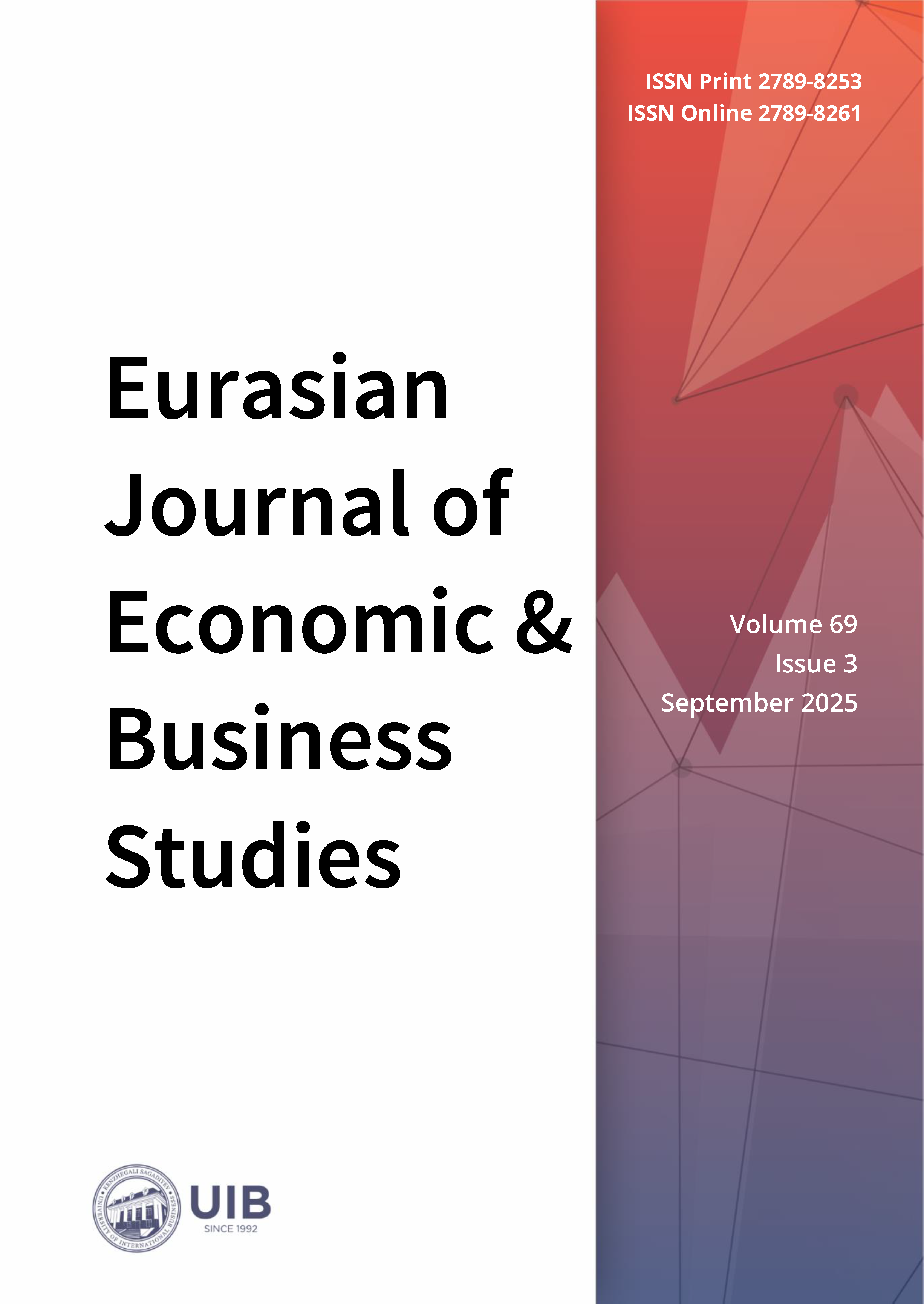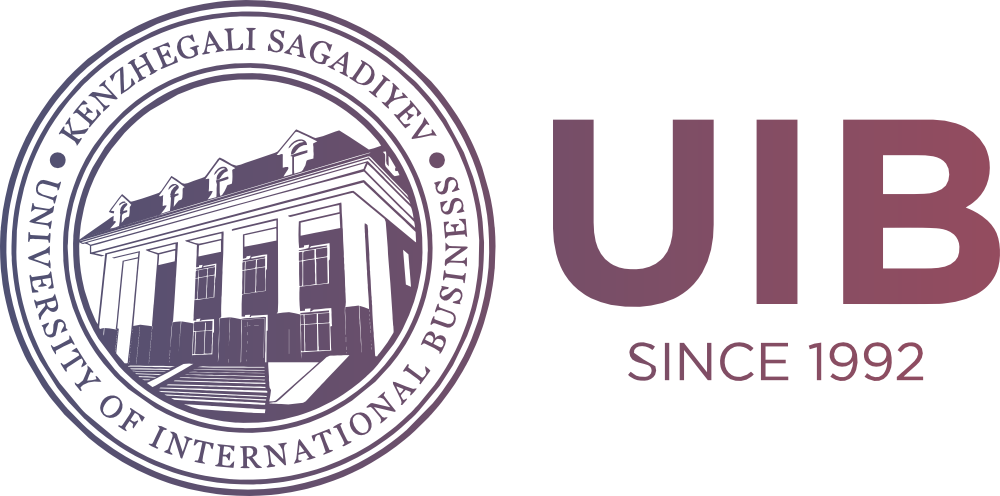Green Economic Development in Kazakhstan: The Role of Public Regulation and Business-Led Investment
DOI:
https://doi.org/10.47703/ejebs.v69i3.548Keywords:
Firm Behavior, Business, Government Regulation, Public Policy, Green Economy, Public Administration, Sustainable DevelopmentAbstract
The transition to a green economy is one of the key priorities for sustainable development, particularly in resource-dependent countries like Kazakhstan. The relevance of this research is determined by the need to balance investment incentives and fiscal instruments to accelerate environmentally oriented transformation. The aim of the article is to identify the mechanisms that have a decisive influence on the formation of a green economy in the Republic of Kazakhstan. The methodology is based on correlation and regression analysis and covers four groups of indicators: environmental investments, tax revenues for resource use, the scale of green construction, and the prevalence of ecological innovations, from 2016 to 2023. The results showed that investment measures do not have a statistically significant effect on the spread of environmental innovations (R² = 0.620, p > 0.3). On the contrary, fiscal instruments, in particular taxes on the use of natural resources, demonstrated a positive relationship with the volume of green construction (R² = 0.504, p = 0.048). Tax pressure can stimulate the behavioral transformation of businesses towards environmentally sustainable practices. Institutional conditions demonstrated higher efficiency compared to investment incentives. The mandatory regulatory instruments in the formation of green economy elements proved effective. The limited effectiveness of voluntary investment measures confirms the stronger regulatory role of fiscal mechanisms. State policy should focus on strengthening institutional regulation and developing targeted tax instruments to promote sustainable economic transformation in Kazakhstan.
Downloads
References
Bailey, I. (2002). European environmental taxes and charges: economic theory and policy practice. Applied Geography, 22(3), 235-251. https://doi.org/10.1016/S0143-6228(02)00011-5
Chang, R. D., Soebarto, V., Zhao, Z. Y., & Zillante, G. (2016). Facilitating the transition to sustainable construction: China's policies. Journal of Cleaner Production, 131, 534-544. http://dx.doi.org/10.1016/j.jclepro.2016.04.147
Chien, F., Ngo, Q. T., Hsu, C. C., Chau, K. Y., & Iram, R. (2021). Assessing the mechanism of barriers towards green finance and public spending in small and medium enterprises from developed countries. Environmental Science and Pollution Research, 28(43), 60495-60510. https://doi.org/10.1007/s11356-021-14907-1
Diyar, S., Akparova, A., Toktabayev, A., & Tyutunnikova, M. (2014). Green economy–innovation-based development of Kazakhstan. Procedia-Social and Behavioral Sciences, 140, 695-699. https://doi.org/10.1016/j.sbspro.2014.04.497
Dulal, H. B., Dulal, R., & Yadav, P. K. (2015). Delivering green economy in Asia: The role of fiscal instruments. Futures, 73, 61-77. https://doi.org/10.1016/j.futures.2015.08.002
Ehresman, T. G., & Okereke, C. (2015). Environmental justice and conceptions of the green economy. International Environmental Agreements: Politics, Law and Economics, 15(1), 13-27. https://doi.org/10.1007/s10784-014-9265-2
Falcone, P. M. (2020). Environmental regulation and green investments: The role of green finance. International Journal of Green Economics, 14(2), 159-173. https://doi.org/10.1504/IJGE.2020.109735
Fabrizi, A., Gentile, M., Guarini, G., & Meliciani, V. (2024). The impact of environmental regulation on innovation and international competitiveness. Journal of Evolutionary Economics, 34(1), 169-204. https://doi.org/10.1007/s00191-024-00852-y
Georgeson, L., Maslin, M., & Poessinouw, M. (2017). The global green economy: a review of concepts, definitions, measurement methodologies and their interactions. Geo: Geography and Environment, 4(1), e00036. https://doi.org/10.1002/geo2.36
Hawkins, R. (2000). The use of economic instruments and green taxes to complement an environmental regulatory regime. Water, air, and soil pollution, 123(1), 379-394. https://doi.org/10.1023/A:1005294917875
Imangali, Z., & Bekturganova, M. (2024). Sustainable growth in Kazakhstan: Green economy, decarbonization and energy transition. Technoeconomics., 3 1(8), 14-25. https://doi.org/10.57809/2024.3.1.8.2
International Monetary Fund (IMF). (2022). World economic outlook: War sets back the global recovery. World Bank. (2022). Retrieved August 23, 2025, from World development report 2022: Finance for an equitable recovery. World Bank. https://www.worldbank.org/en/publication/wdr2022
Khan, S., Akbar, A., Nasim, I., Hedvičáková, M., & Bashir, F. (2022). Green finance development and environmental sustainability: A panel data analysis. Frontiers in Environmental Science, 10, 1039705. https://doi.org/10.3389/fenvs.2022.1039705
Kiefer, C. P., Del Río González, P., & Carrillo‐Hermosilla, J. (2019). Drivers and barriers of eco‐innovation types for sustainable transitions: A quantitative perspective. Business Strategy and the Environment, 28(1), 155-172. https://doi.org/10.1002/bse.2246
Khoshnava, S. M., Rostami, R., Zin, R. M., Štreimikienė, D., Yousefpour, A., Strielkowski, W., & Mardani, A. (2019). Aligning the criteria of green economy (GE) and sustainable development goals (SDGs) to implement sustainable development. Sustainability, 11(17), 4615. https://doi.org/10.3390/su11174615
Ljubičić, I. (2025). Tax Instruments as a Key Driver of the Green Transition: The Role of Fiscal Policy in Sustainable Development. Journal of Agronomy, Technology and Engineering Management, 8(1), 1347-1354. https://doi.org/10.55817/GZOG5027
Lo, A. Y., & Howes, M. (2013). Powered by the state or finance? The organization of China’s carbon markets. Eurasian Geography and Economics, 54(4), 386-408. http://dx.doi.org/10.1080/15387216.2013.870794
Ma, X., Ock, Y. S., Wu, F., & Zhang, Z. (2022). The effect of internal control on green innovation: corporate environmental investment as a mediator. Sustainability, 14(3), 1755. https://doi.org/10.3390/su14031755
Meng, F., Guo, J., Guo, Z., Lee, J. C., Liu, G., & Wang, N. (2021). Urban ecological transition: The practice of ecological civilization construction in China. Science of the Total Environment, 755, 142633. https://doi.org/10.1016/j.scitotenv.2020.142633
Merino-Saum, A., Baldi, M. G., Gunderson, I., & Oberle, B. (2018). Articulating natural resources and sustainable development goals through green economy indicators: A systematic analysis. Resources, Conservation and Recycling, 139, 90-103. https://doi.org/10.1016/j.resconrec.2018.07.007
Morgera, E., & Savaresi, A. (2013). A conceptual and legal perspective on the green economy. Review of European, Comparative & International Environmental Law, 22(1), 14-28. https://doi.org/10.1111/reel.12016
National Development and Reform Commission of the People’s Republic of China. (2021). Outline of the 14th five-year plan for national economic and social development and the long-range objectives through the year 2035. Retrieved August 23, 2025, from http://en.ndrc.gov.cn/policies/202203/P020220315511326748336.pdf
Oliinyk, N. (2020). Conceptual foundations of “green” economy in the context of sustainable development. Social Economics, (60), 19-28. https://doi.org/10.26565/2524-2547-2020-60-02
Organisation for Economic Co-operation and Development. (2020). Green growth and sustainable development 2020. European Sustainable Development Network. Retrieved August 23, 2025, from https://www.esdn.eu/fileadmin/ESDN_Reports/ESDN_Report_2_2020.pdf
Porfiriev, B. N., Dmitriev, A., Vladimirova, I., & Tsygankova, A. (2017). Sustainable development planning and green construction for building resilient cities: Russian experiences within the international context. Environmental Hazards, 16(2), 165-179. https://doi.org/10.1080/17477891.2017.1280000
Renewable Market Watch. (2018). Kazakhstan to focus on renewable energy for power generation mix diversification and improvement. Renewable Market Watch. Retrieved August 23, 2025, from https://renewablemarketwatch.com/news-analysis/260-kazakhstan-to-focus-on-renewable-energy-for-power-generation-mix-diversification-and-improvement
Söderholm, P. (2006). Environmental taxation in the natural resource extraction sector: is it a good idea? European environment, 16(4), 232-245. https://doi.org/10.1002/eet.415
Toprak, D. (2018). Environmental policies and fiscal Instruments in the context of sustainable development: An analysis of environmental taxes. Journal of Mehmet Akif Ersoy University Economics and Administrative Sciences Faculty, 5(3), 812-838. https://doi.org/10.30798/makuiibf.419655
Trushkina, N. (2022). Green economy in the conditions of modern challenges: conceptual frameworks. International Science Journal of Management, Economics & Finance, 1(1). Retrieved from https://isg-journal.com/isjmef/article/view/3
United Nations, Department of Economic and Social Affairs. (2021). Sustainable development outlook 2021: From anguish to determination. United Nations. Retrieved August 23, 2025, from https://www.un.org/development/desa/dpad/wp-content/uploads/sites/45/publication/SDO_2021_Full_Report.pdf
Yang, Q., Ming, S., Zhang, R., & Yan, H. (2024). Green finance and corporate environmental investment:" Scale Up" or" Efficiency Up"? PLOS one, 19(2), e0297456. https://doi.org/10.1371/journal.pone.0297456
Yesbergen, R., Maukenova, A., Gumar, N., Shalbaeva, S., & Kalieva, G. (2024). Path to Green Economy: Analyzing Innovation, Investment and Taxation in Kazakhstan. Eurasian Journal of Economic and Business Studies, 68(3), 36-50. https://doi.org/10.47703/ejebs.v68i3.415
Yessimkhan, G., & Sartanova, N. (2024). Ensuring sustainable agricultural development in Kazakhstan: Sources of funding. International Journal of Food System Dynamics, 15(3). https://doi.org/10.18461/ijfsd.v15i3.L0
How to Cite
Downloads
Published
Issue
Section
License

This work is licensed under a Creative Commons Attribution 4.0 International License.
Authors retain copyright and grant the journal right of first publication with the work simultaneously licensed under a Creative Commons Attribution (CC-BY) 4.0 License that allows others to share the work with an acknowledgment of the work’s authorship and initial publication in this journal.



